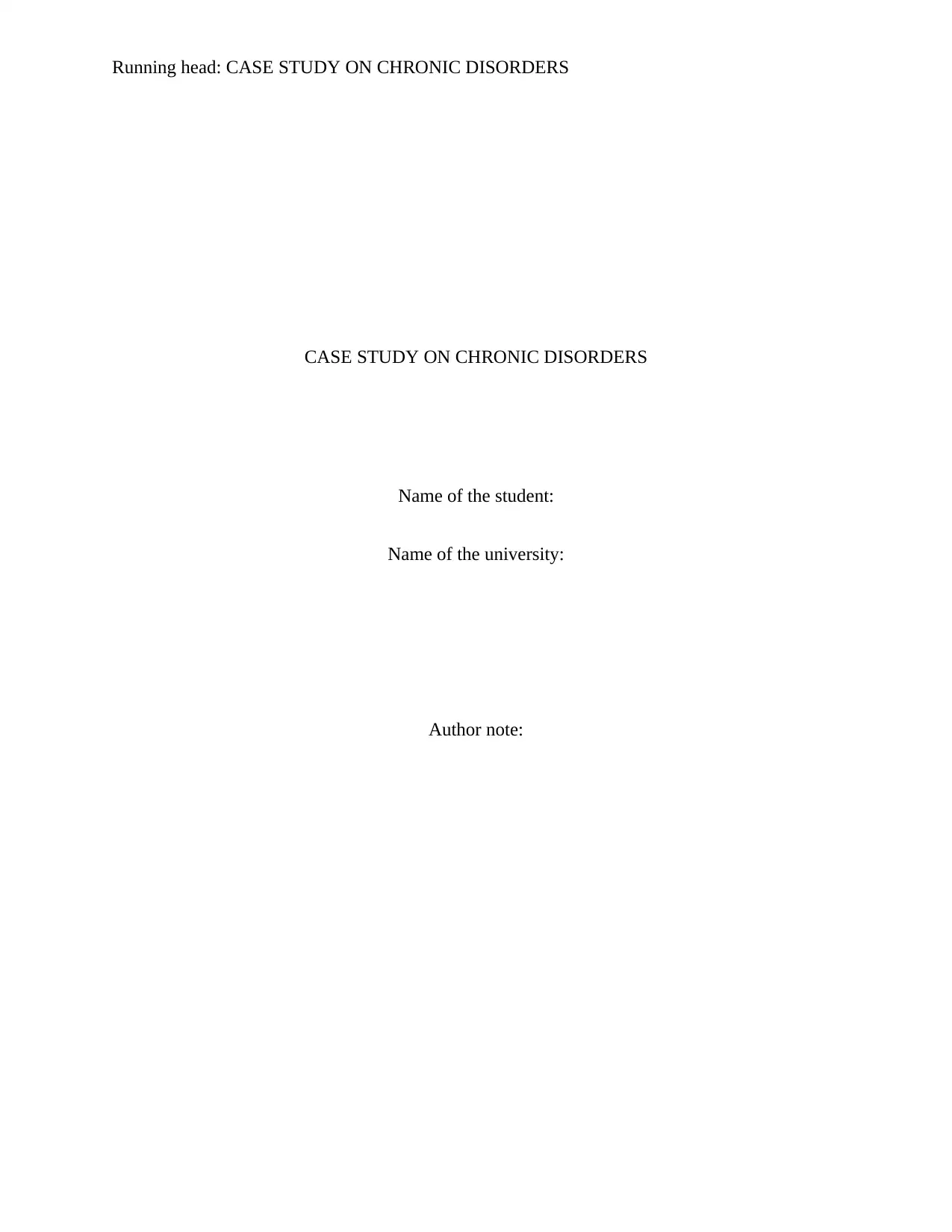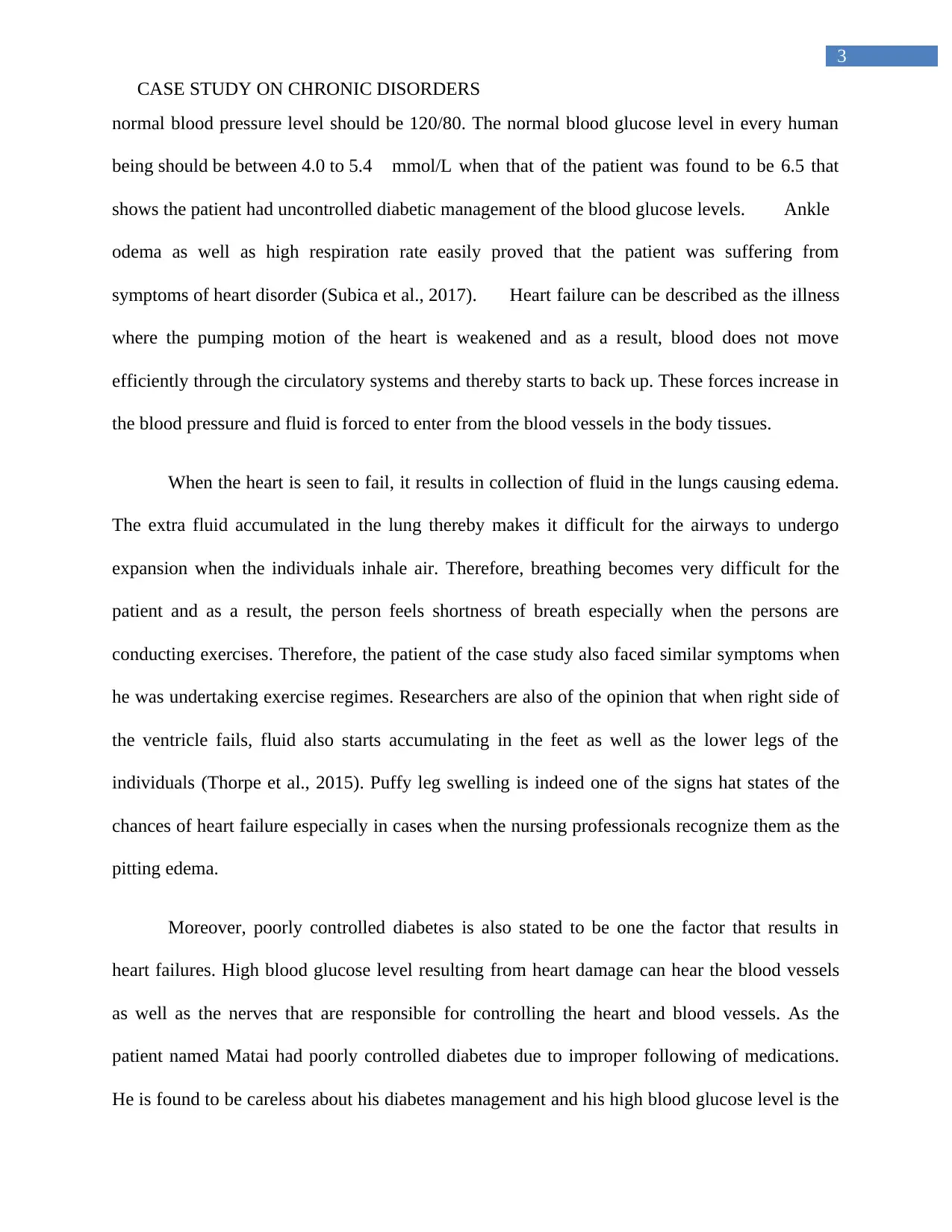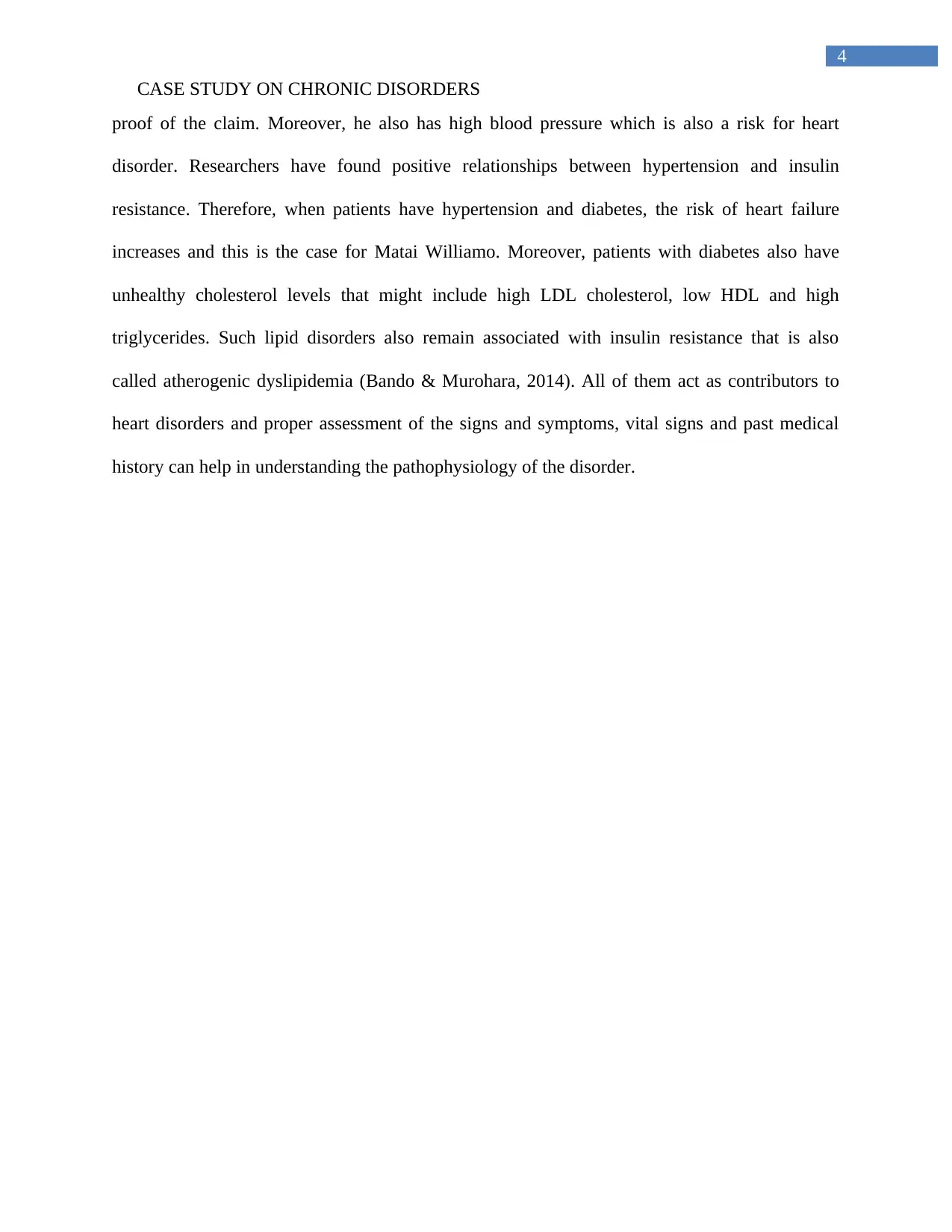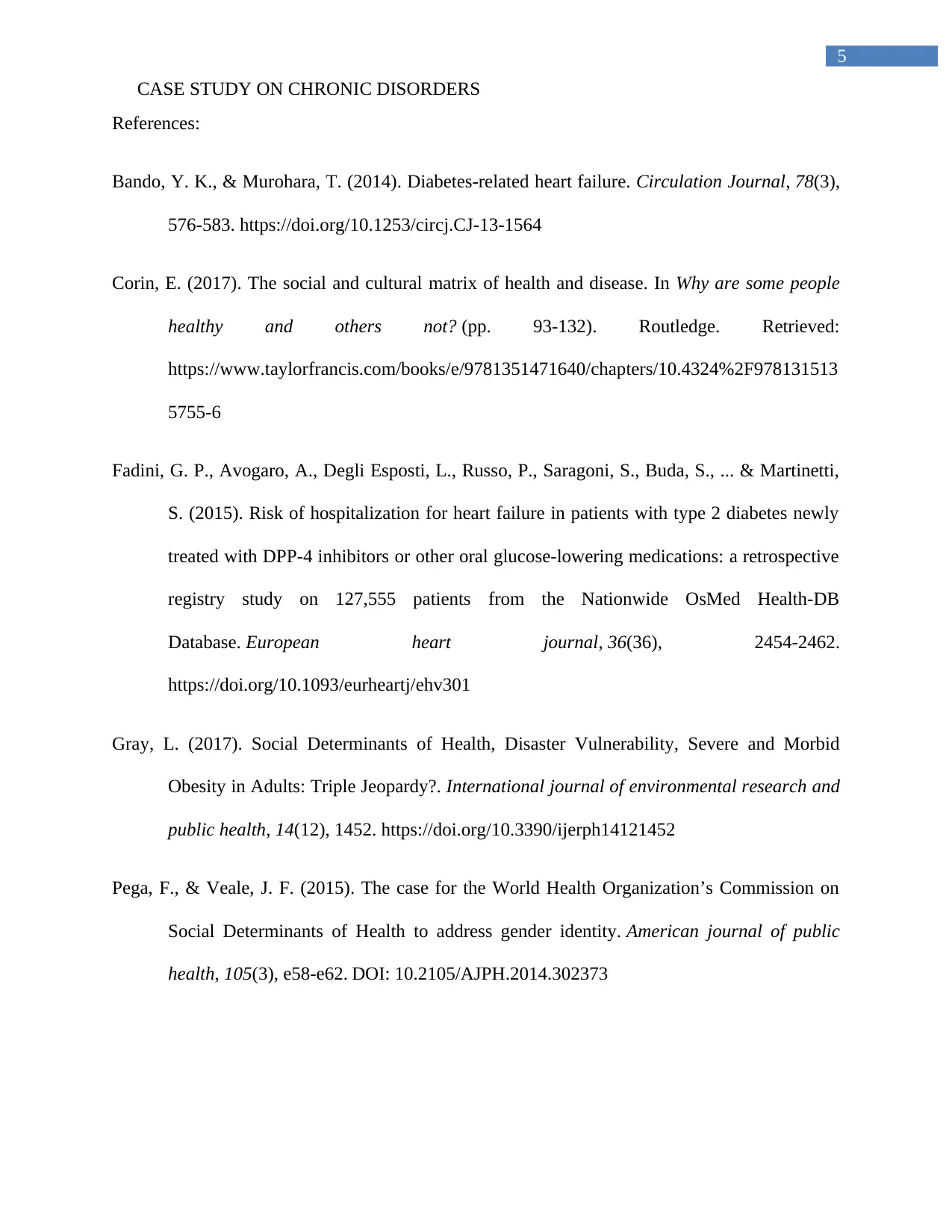Case Study: Chronic Heart Failure and Social Determinants of Health
VerifiedAdded on 2023/06/10
|7
|1719
|380
Case Study
AI Summary
This case study examines the health of a Samoan patient, Matai Williamo, diagnosed with heart disorders and diabetes, highlighting the influence of social determinants of health and cultural factors. The assignment explores how these factors impact the patient's health literacy, diabetes management, and adherence to medical advice. It analyzes assessment data, including vital signs and abnormal respiratory rates, to understand the pathophysiology of the patient's conditions. The study emphasizes the importance of identifying social determinants to develop effective care plans and lifestyle management strategies. Cultural beliefs, such as the Samoan perception of body size, are examined for their impact on health outcomes, and the patient's lack of health literacy is identified as a barrier to effective self-management. The case study also discusses the link between poorly controlled diabetes, hypertension, and heart failure, as well as the role of unhealthy cholesterol levels. The study is supported by references to peer-reviewed articles and clinical guidelines to demonstrate the effects of social determinants of health and cultural beliefs.

Running head: CASE STUDY ON CHRONIC DISORDERS
CASE STUDY ON CHRONIC DISORDERS
Name of the student:
Name of the university:
Author note:
CASE STUDY ON CHRONIC DISORDERS
Name of the student:
Name of the university:
Author note:
Paraphrase This Document
Need a fresh take? Get an instant paraphrase of this document with our AI Paraphraser

1
CASE STUDY ON CHRONIC DISORDERS
Social determinants of health can affect the health of different individuals and therefore
need to be identified by professionals so that they can develop care plans and advise patients
with effective lifestyle management. This assignment will mainly help in pointing two important
arenas through the case study of a Samoan patient who had been diagnosed with heart disorders
and have diabetes and other disorders as well. This will show how identifying the social
determinants of health and conducting of proper health assessment help individuals to understand
the pathophysiology that is resulting in poor quality life of the patient.
Social determinants of health can be described as the conditions of the environment
where people takes birth, live, play, work, worship as well as age which affects the health and
disrupts the normal functioning of life. It has tremendous impacts on the quality of outcomes in
the daily life of the individuals and exposes them to different types of physical, mental and
financial risks. Statistical data have shown that Samoan born migrants in the nation of
Queensland are found to be present in the disproportionate manner in the middle to low income
brackets (Torres et al., 2015). Levels of education as well as employment of such people in the
nation of Australia are seen to be much lower in comparison to that of the general population.
Only 25% of the Samoan born people are seen to fall in the category of higher education in
comparison to that of the 56% of the total population (Corin, 2017).
Poor health literacy is also one of the social determinants of health that is mainly
evidenced by lack of knowledge as well as awareness of available health services. Moreover, low
many of the researchers are also of the opinion that cultural beliefs and attitudes of the Samoans
also affect the health literacy (Torres et al., 2015). This can be explained with the help of an
example where sickness is considered not only as the physiological condition affecting the health
but also as the social or familial circumstance. Therefore, individual tend to procrastinate with
CASE STUDY ON CHRONIC DISORDERS
Social determinants of health can affect the health of different individuals and therefore
need to be identified by professionals so that they can develop care plans and advise patients
with effective lifestyle management. This assignment will mainly help in pointing two important
arenas through the case study of a Samoan patient who had been diagnosed with heart disorders
and have diabetes and other disorders as well. This will show how identifying the social
determinants of health and conducting of proper health assessment help individuals to understand
the pathophysiology that is resulting in poor quality life of the patient.
Social determinants of health can be described as the conditions of the environment
where people takes birth, live, play, work, worship as well as age which affects the health and
disrupts the normal functioning of life. It has tremendous impacts on the quality of outcomes in
the daily life of the individuals and exposes them to different types of physical, mental and
financial risks. Statistical data have shown that Samoan born migrants in the nation of
Queensland are found to be present in the disproportionate manner in the middle to low income
brackets (Torres et al., 2015). Levels of education as well as employment of such people in the
nation of Australia are seen to be much lower in comparison to that of the general population.
Only 25% of the Samoan born people are seen to fall in the category of higher education in
comparison to that of the 56% of the total population (Corin, 2017).
Poor health literacy is also one of the social determinants of health that is mainly
evidenced by lack of knowledge as well as awareness of available health services. Moreover, low
many of the researchers are also of the opinion that cultural beliefs and attitudes of the Samoans
also affect the health literacy (Torres et al., 2015). This can be explained with the help of an
example where sickness is considered not only as the physiological condition affecting the health
but also as the social or familial circumstance. Therefore, individual tend to procrastinate with

2
CASE STUDY ON CHRONIC DISORDERS
their health until the disorder becomes worse. Many of the researchers have found out a peculiar
thinking where the Samoans believe reveal an individual with large body size with power, wealth
and prosperity in the Samoan culture (Pega & Veale, 2015).
In case of Matai Williamo, it was found that he had no health literacy about his disorders
and was only following the previous doctor’s advice blindly n taking 30 minutes walk every day.
He had no idea about the importance of diabetes management and therefore he was not careful
about taking the correct medications and checking the blood glucose level every day. As their
culture believes in the concept of developing bid body size, therefore the diet which they
undertake may result in negative effects on the health (Gray, 2017). Diabetes and heart disorders
are the immediate issues that are also observed in the patient named Matai Williamo in the case
study. This cultural traditions support taking of diet that are huge in amount and are mainly rich
in the saturated fat as well as energy dense, nutrients poor foods that result in developing
situations like obesity or make them overweight.
Researchers are of the opinion that food related risk factors are mainly seen to include
uncontrolled diabetes, high blood pressure, obesity as well as high amount of saturated fat
(Fadini et al., 2015). All such issues were found to be present in the patient of the case study and
this resulted in the risk if the heart disorder that mainly showed the signs of congestive heart
failure signs for the future.
The nursing professionals mainly conduct two types of assessment. One of them is the
objective assessment. One of the abnormal rate which was found is the respiratory rate where the
patient had 24 breaths per minute when normal respiratory rate in adults should be 12 to 20
breaths per minute. The blood pressure was also found to be quite high about 145/90 when the
CASE STUDY ON CHRONIC DISORDERS
their health until the disorder becomes worse. Many of the researchers have found out a peculiar
thinking where the Samoans believe reveal an individual with large body size with power, wealth
and prosperity in the Samoan culture (Pega & Veale, 2015).
In case of Matai Williamo, it was found that he had no health literacy about his disorders
and was only following the previous doctor’s advice blindly n taking 30 minutes walk every day.
He had no idea about the importance of diabetes management and therefore he was not careful
about taking the correct medications and checking the blood glucose level every day. As their
culture believes in the concept of developing bid body size, therefore the diet which they
undertake may result in negative effects on the health (Gray, 2017). Diabetes and heart disorders
are the immediate issues that are also observed in the patient named Matai Williamo in the case
study. This cultural traditions support taking of diet that are huge in amount and are mainly rich
in the saturated fat as well as energy dense, nutrients poor foods that result in developing
situations like obesity or make them overweight.
Researchers are of the opinion that food related risk factors are mainly seen to include
uncontrolled diabetes, high blood pressure, obesity as well as high amount of saturated fat
(Fadini et al., 2015). All such issues were found to be present in the patient of the case study and
this resulted in the risk if the heart disorder that mainly showed the signs of congestive heart
failure signs for the future.
The nursing professionals mainly conduct two types of assessment. One of them is the
objective assessment. One of the abnormal rate which was found is the respiratory rate where the
patient had 24 breaths per minute when normal respiratory rate in adults should be 12 to 20
breaths per minute. The blood pressure was also found to be quite high about 145/90 when the
⊘ This is a preview!⊘
Do you want full access?
Subscribe today to unlock all pages.

Trusted by 1+ million students worldwide

3
CASE STUDY ON CHRONIC DISORDERS
normal blood pressure level should be 120/80. The normal blood glucose level in every human
being should be between 4.0 to 5.4 mmol/L when that of the patient was found to be 6.5 that
shows the patient had uncontrolled diabetic management of the blood glucose levels. Ankle
odema as well as high respiration rate easily proved that the patient was suffering from
symptoms of heart disorder (Subica et al., 2017). Heart failure can be described as the illness
where the pumping motion of the heart is weakened and as a result, blood does not move
efficiently through the circulatory systems and thereby starts to back up. These forces increase in
the blood pressure and fluid is forced to enter from the blood vessels in the body tissues.
When the heart is seen to fail, it results in collection of fluid in the lungs causing edema.
The extra fluid accumulated in the lung thereby makes it difficult for the airways to undergo
expansion when the individuals inhale air. Therefore, breathing becomes very difficult for the
patient and as a result, the person feels shortness of breath especially when the persons are
conducting exercises. Therefore, the patient of the case study also faced similar symptoms when
he was undertaking exercise regimes. Researchers are also of the opinion that when right side of
the ventricle fails, fluid also starts accumulating in the feet as well as the lower legs of the
individuals (Thorpe et al., 2015). Puffy leg swelling is indeed one of the signs hat states of the
chances of heart failure especially in cases when the nursing professionals recognize them as the
pitting edema.
Moreover, poorly controlled diabetes is also stated to be one the factor that results in
heart failures. High blood glucose level resulting from heart damage can hear the blood vessels
as well as the nerves that are responsible for controlling the heart and blood vessels. As the
patient named Matai had poorly controlled diabetes due to improper following of medications.
He is found to be careless about his diabetes management and his high blood glucose level is the
CASE STUDY ON CHRONIC DISORDERS
normal blood pressure level should be 120/80. The normal blood glucose level in every human
being should be between 4.0 to 5.4 mmol/L when that of the patient was found to be 6.5 that
shows the patient had uncontrolled diabetic management of the blood glucose levels. Ankle
odema as well as high respiration rate easily proved that the patient was suffering from
symptoms of heart disorder (Subica et al., 2017). Heart failure can be described as the illness
where the pumping motion of the heart is weakened and as a result, blood does not move
efficiently through the circulatory systems and thereby starts to back up. These forces increase in
the blood pressure and fluid is forced to enter from the blood vessels in the body tissues.
When the heart is seen to fail, it results in collection of fluid in the lungs causing edema.
The extra fluid accumulated in the lung thereby makes it difficult for the airways to undergo
expansion when the individuals inhale air. Therefore, breathing becomes very difficult for the
patient and as a result, the person feels shortness of breath especially when the persons are
conducting exercises. Therefore, the patient of the case study also faced similar symptoms when
he was undertaking exercise regimes. Researchers are also of the opinion that when right side of
the ventricle fails, fluid also starts accumulating in the feet as well as the lower legs of the
individuals (Thorpe et al., 2015). Puffy leg swelling is indeed one of the signs hat states of the
chances of heart failure especially in cases when the nursing professionals recognize them as the
pitting edema.
Moreover, poorly controlled diabetes is also stated to be one the factor that results in
heart failures. High blood glucose level resulting from heart damage can hear the blood vessels
as well as the nerves that are responsible for controlling the heart and blood vessels. As the
patient named Matai had poorly controlled diabetes due to improper following of medications.
He is found to be careless about his diabetes management and his high blood glucose level is the
Paraphrase This Document
Need a fresh take? Get an instant paraphrase of this document with our AI Paraphraser

4
CASE STUDY ON CHRONIC DISORDERS
proof of the claim. Moreover, he also has high blood pressure which is also a risk for heart
disorder. Researchers have found positive relationships between hypertension and insulin
resistance. Therefore, when patients have hypertension and diabetes, the risk of heart failure
increases and this is the case for Matai Williamo. Moreover, patients with diabetes also have
unhealthy cholesterol levels that might include high LDL cholesterol, low HDL and high
triglycerides. Such lipid disorders also remain associated with insulin resistance that is also
called atherogenic dyslipidemia (Bando & Murohara, 2014). All of them act as contributors to
heart disorders and proper assessment of the signs and symptoms, vital signs and past medical
history can help in understanding the pathophysiology of the disorder.
CASE STUDY ON CHRONIC DISORDERS
proof of the claim. Moreover, he also has high blood pressure which is also a risk for heart
disorder. Researchers have found positive relationships between hypertension and insulin
resistance. Therefore, when patients have hypertension and diabetes, the risk of heart failure
increases and this is the case for Matai Williamo. Moreover, patients with diabetes also have
unhealthy cholesterol levels that might include high LDL cholesterol, low HDL and high
triglycerides. Such lipid disorders also remain associated with insulin resistance that is also
called atherogenic dyslipidemia (Bando & Murohara, 2014). All of them act as contributors to
heart disorders and proper assessment of the signs and symptoms, vital signs and past medical
history can help in understanding the pathophysiology of the disorder.

5
CASE STUDY ON CHRONIC DISORDERS
References:
Bando, Y. K., & Murohara, T. (2014). Diabetes-related heart failure. Circulation Journal, 78(3),
576-583. https://doi.org/10.1253/circj.CJ-13-1564
Corin, E. (2017). The social and cultural matrix of health and disease. In Why are some people
healthy and others not? (pp. 93-132). Routledge. Retrieved:
https://www.taylorfrancis.com/books/e/9781351471640/chapters/10.4324%2F978131513
5755-6
Fadini, G. P., Avogaro, A., Degli Esposti, L., Russo, P., Saragoni, S., Buda, S., ... & Martinetti,
S. (2015). Risk of hospitalization for heart failure in patients with type 2 diabetes newly
treated with DPP-4 inhibitors or other oral glucose-lowering medications: a retrospective
registry study on 127,555 patients from the Nationwide OsMed Health-DB
Database. European heart journal, 36(36), 2454-2462.
https://doi.org/10.1093/eurheartj/ehv301
Gray, L. (2017). Social Determinants of Health, Disaster Vulnerability, Severe and Morbid
Obesity in Adults: Triple Jeopardy?. International journal of environmental research and
public health, 14(12), 1452. https://doi.org/10.3390/ijerph14121452
Pega, F., & Veale, J. F. (2015). The case for the World Health Organization’s Commission on
Social Determinants of Health to address gender identity. American journal of public
health, 105(3), e58-e62. DOI: 10.2105/AJPH.2014.302373
CASE STUDY ON CHRONIC DISORDERS
References:
Bando, Y. K., & Murohara, T. (2014). Diabetes-related heart failure. Circulation Journal, 78(3),
576-583. https://doi.org/10.1253/circj.CJ-13-1564
Corin, E. (2017). The social and cultural matrix of health and disease. In Why are some people
healthy and others not? (pp. 93-132). Routledge. Retrieved:
https://www.taylorfrancis.com/books/e/9781351471640/chapters/10.4324%2F978131513
5755-6
Fadini, G. P., Avogaro, A., Degli Esposti, L., Russo, P., Saragoni, S., Buda, S., ... & Martinetti,
S. (2015). Risk of hospitalization for heart failure in patients with type 2 diabetes newly
treated with DPP-4 inhibitors or other oral glucose-lowering medications: a retrospective
registry study on 127,555 patients from the Nationwide OsMed Health-DB
Database. European heart journal, 36(36), 2454-2462.
https://doi.org/10.1093/eurheartj/ehv301
Gray, L. (2017). Social Determinants of Health, Disaster Vulnerability, Severe and Morbid
Obesity in Adults: Triple Jeopardy?. International journal of environmental research and
public health, 14(12), 1452. https://doi.org/10.3390/ijerph14121452
Pega, F., & Veale, J. F. (2015). The case for the World Health Organization’s Commission on
Social Determinants of Health to address gender identity. American journal of public
health, 105(3), e58-e62. DOI: 10.2105/AJPH.2014.302373
⊘ This is a preview!⊘
Do you want full access?
Subscribe today to unlock all pages.

Trusted by 1+ million students worldwide

6
CASE STUDY ON CHRONIC DISORDERS
Subica, A. M., Agarwal, N., Sullivan, J. G., & Link, B. G. (2017). Obesity and Associated
Health Disparities Among Understudied Multiracial, Pacific Islander, and American
Indian Adults. Obesity, 25(12), 2128-2136. https://doi.org/10.1002/oby.21954
Thorpe Jr, R. J., Duru, O. K., & Hill, C. V. (2015). Advancing racial/ethnic minority men’s
health using a life course approach. Ethnicity & disease, 25(3), 241.
doi: 10.18865/ed.25.3.241
Torres, A., Blasi, F., Dartois, N., & Akova, M. (2015). Which individuals are at increased risk of
pneumococcal disease and why? Impact of COPD, asthma, smoking, diabetes, and/or
chronic heart disease on community-acquired pneumonia and invasive pneumococcal
disease. Thorax, thoraxjnl-2015. http://dx.doi.org/10.1136/thoraxjnl-2015-206780
CASE STUDY ON CHRONIC DISORDERS
Subica, A. M., Agarwal, N., Sullivan, J. G., & Link, B. G. (2017). Obesity and Associated
Health Disparities Among Understudied Multiracial, Pacific Islander, and American
Indian Adults. Obesity, 25(12), 2128-2136. https://doi.org/10.1002/oby.21954
Thorpe Jr, R. J., Duru, O. K., & Hill, C. V. (2015). Advancing racial/ethnic minority men’s
health using a life course approach. Ethnicity & disease, 25(3), 241.
doi: 10.18865/ed.25.3.241
Torres, A., Blasi, F., Dartois, N., & Akova, M. (2015). Which individuals are at increased risk of
pneumococcal disease and why? Impact of COPD, asthma, smoking, diabetes, and/or
chronic heart disease on community-acquired pneumonia and invasive pneumococcal
disease. Thorax, thoraxjnl-2015. http://dx.doi.org/10.1136/thoraxjnl-2015-206780
1 out of 7
Related Documents
Your All-in-One AI-Powered Toolkit for Academic Success.
+13062052269
info@desklib.com
Available 24*7 on WhatsApp / Email
![[object Object]](/_next/static/media/star-bottom.7253800d.svg)
Unlock your academic potential
Copyright © 2020–2025 A2Z Services. All Rights Reserved. Developed and managed by ZUCOL.





